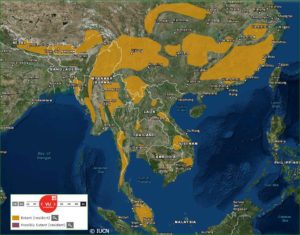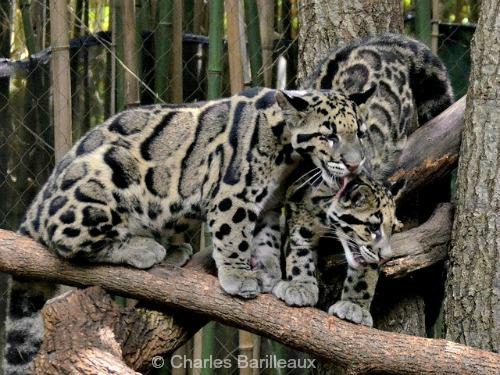- HB Length: 68-106 cm (27-42″)
- Tail Length:61-84 cm (24-33″)
- Height: Appr. 53 cm (21″)
- Weight:11-23 kg (24-50 lbs)
- Pop. Trend: Decreasing
Clouded Leopards Neofelis nebulosa are so named because of the large, blotchy, cloud-like markings on their body, head, legs and tail. There may also be some smaller, solid spots on the head and legs. The rather long, slim body is usually greyish brown to yellowish brown in colour, and the cheeks and neck are striped with black. The underparts and inner sides of the legs are white or pale tawny in colour. The long and rather narrow head has a broad muzzle; irises of brownish yellow to greyish green; and ears that are short, round, and dark on the backs with white central spots. The legs are rather stout, with the hind legs noticeably longer than the front, and broad paws. The long, well furred tail is marked with rings, tipped with black or grey and can reach 1 metre in length.
Flexible ankle joints enable Clouded Leopards to climb down trees head first, a trait shared with the Margay Leopardus wiedi, of Central and South America. Their upper canines are relatively longer than those of any other living cat, and may be an adaptation to holding onto prey caught in the trees, a more difficult feat than catching it on the ground.
Distribution

Clouded Leopards are found from 2,500 metres in the Himalayan foothills of Nepal, though mainland southeast Asia into China. They are strongly associated with tropical evergreen rainforest, but there are records from dry and secondary logged forests.
From 1998-2002, researchers from Texas A & M carried out the first field study of Clouded Leopards in a nature sanctuary in Thailand. Two males and two female cats were radio-collared and tracked 7-17 months.Their annual home ranges were 22.9 -51.9 km2, and there was no difference in the range sizes of the sexes. The cats travelled an average of 1,932 metres per day, and intensively used a 3.6-8 km2 core area of their range.
A further Thailand study a park in 2003 showed home ranges of females to be 22-25.7km2, while those of the males were 29.7-49.1 km2. Core ranges were smaller, possibly indicating higher numbers of prey species.
In both studies, the ranges of the males overlapped those of the females, and there was some evidence of male overlapping ranges.
In 2006, the Clouded Leopard population was split into two separate species, based on genetic analysis. Those on the island of Borneo were given the new species status of Neofelis diardi, and called the Sunda or Diardi’s Clouded Leopard.
Ecology
Animals in Thailand showed a strong preference for dense evergreen forest, and were active day and night with significant activity increases at dusk and dawn. Activity was also recorded in savannah, an abandoned orchard, along streams and main paved roads.
An increasing number of camera trap photos show activity both day and night. They are less active around midday, and in predawn hours. These highly arboreal cats use trees for hunting and resting, but use the ground for travelling and also some hunting.
In the Thailand study, researchers found all recorded locations for one male in open forest grassland were at night. The animal would rest along the forest edge until nightfall and then venture out to hunt hog deer and muntjac, which bedded down en masse after sunset.
Reproduction
Births in captivity have occurred from March through August but animals having a tropical distribution often don’t have a well defined reproductive season. Clouded Leopards are thought to give birth in nest-like structures above ground in hollow trees,but ground level dens in thick vegetation have also been found. One to five, usually two, kittens are born after a gestation period of 86 – 93 days. Kittens weigh 140 – 280 grams at birth, their eyes open after 10 – 12 days, they begin to walk at 19 – 20 days, take solid food at about 10 weeks and will nurse for up to five months. Full adult colouration is attained around six months, and independence from the female occurs by ten months of age. Sexual maturity occurs between 24 and 36 months, and captive animals have lived to 17 years.
Conservation
These Leopards are sacred to some native populations of South East Asia. The Malaysians call them ‘tree tigers’ because they have been seen resting in the branches of trees. The Chinese call them ‘mint leopards’ because their spots remind them of mint leaves. Unfortunately, none of these names has helped protect them from being hunted.
Clouded Leopards are still widely hunted for their teeth and decorative pelt, and for bones for the traditional Asian medicinal market. In Sarawak, their long canine teeth are used by certain tribes as ornaments in their ears. Clouded Leopard pelts were the most commonly available felid pelts in a survey of black market wildlife traders in China in 1991. They are also featured on restaurant menus in Thailand and China catering to wealthy Asian tourists while poachers capture live animals for the illegal pet trade.
See also the Sunda Clouded Leopard page.
Range map IUCN Red List (2008)
Updated 2014


Talk to Us!